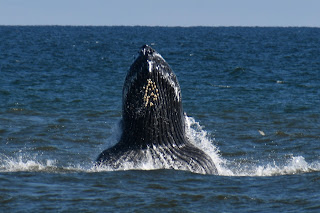Bird Watching Turned Whale Watching 10/19/2023
On Wednesday I wrapped up my day of birding at Island Beach State Park with a drive along the beach. It was a nice day, and I was picking up most of the usual fall birds. While I was scanning the ocean for a possible jaeger (or two), I saw a blow spout not too far off of the beach. Whale sightings from the beach are not rare, especially this time of the year. Large schools of menhaden (bunker as we call them here), peanut bunker and other bait fish are plentiful now and right along the beach. Eventually striped bass and bluefish will find this bait, but for now bottlenose dolphin and humpback whales are following the bait.
Humpback whale "waving" with one of its pectoral fins. © S. Weiss
I enjoy watching whales any time, whether it be from the beach or a boat. They are mammals like us. They breathe air, give live birth to their young and nurse them with mother’s milk. And, I take the word of the biologists on this, they even have hair! Yet they remain mysterious to most of us, living their whole lives in the sea.
On this occasion I noticed there were actually two humpback whales together. To make this sighting even better was seeing them come out of the water to feed, a technique called lunge feeding. Every now and then as I watched them, one or both would come partially out of the water with jaws wide open to take a mouthful of fish, then crash back down into the water. Over about an hour and a half I tried to get as many photos as I could. They probably breached about half a dozen times. The whales did not give any forewarning as to when they would break the water surface, so getting quality focused shots was challenging, or lucky at best.
Two humpback whales feeding and interacting off of the beach. © S. Weiss
On Thursday, I returned to the beach specifically to find and watch the whales again. I took my sister for the ride. She likes to see whales too, but most of the time she and whales are never around at the same time. She gets mad, in a sisterly way, when I show her my whale photos. After driving the beach for a while, I drove back to the same general area as the previous day, and ironically at about the same time too. It was almost instantly that we saw a blow spot. This time there was only one whale around, but it was closer than yesterday. It did not take long before the giant mammal lunged out of the water to swallow some small fish. My sister’s jinx was finally over. We followed the sea creature for about an hour and a half, back and forth along a portion of the beach, watching it lunge probably a couple dozen times.
The small bait fish would scatter for their lives as the whale surfaces with open mouth from below. © S. Weiss
Humpback whale lunging from the water to take a mouthful of small fish. © S. Weiss
The charcoal gray object seen between the whales two open jaws in the middle photograph is not its tongue, but its baleen. The baleen plates are strainers, made up of keratin, that filter the water out of its mouth and traps the fish inside. The whale's eye is located near the downward curve of the mouth line, in the vicinity of the white spot in the bottom photo.
The humpback whale's throat expands to take in the water from its lunge feeding. © S. Weiss
The whale's throat ridges are called ventral grooves. These grooves, or folds, allow the throat to expand to accommodate the massive quantity of water that the whale gulps when feeding. The water is quickly expelled through the baleen before the whale swallows its prey. The throat grooves may be the origin of the word given to the family of baleen whales known as Rorquals.
The head of a humpback whale before dropping back under the surface. © S. Weiss
The bumps on the front of the whale's head, across the top and bottom of its mouth are tubercles. The tubercles around the mouth or jaws are follicles, each with a single sensory hair. These tubercles are different than the tubercles on the whale's pectoral fin, or flipper (see first photo at of page). These tubercles on the leading edge of the flipper are performance-enhancing features of the whale's maneuverability. Other scientists are studying these features for applications in our mechanical world.
Earlier on in this encounter I noticed a sign that the whale was about to break the surface: the bait fish would scatter across the water, trying to jump out of the way before being swallowed alive. This did help me get some better pictures, just not on every lunge. When we finally decided to leave, we noticed that there were two, maybe three other whales spouting within eyesight of our location. They showed no intentions of moving closer to shore, so we left them for another day. Hopefully I can share the next whale watching experience with my wife.














Comments
Post a Comment